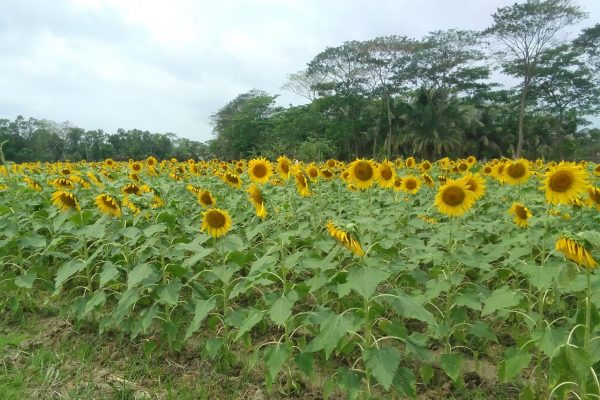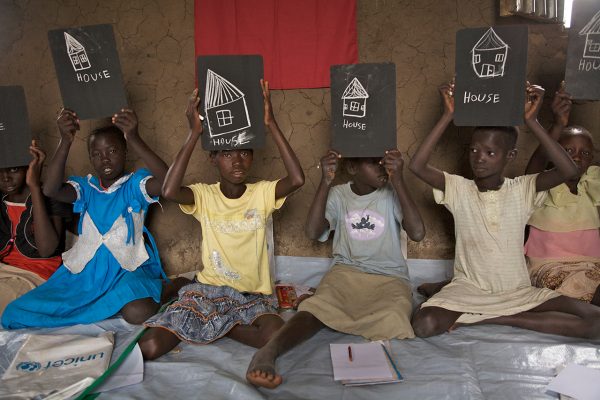Five years on: Looking back at the first 12 months of the Rohingya crisis
Reading Time: 8 minutes
On 25 August 2017, hundreds of thousands of people from the Rohingya community fled persecution in Myanmar, and arrived in Bangladesh. Five years on, we recount the first days of the emergency response, and how the crisis unfolded into the most pressing humanitarian crisis of it’s time. This blog post was written on 24 August, 2018, one year since the influx began.
I was hiking through Teknaf Wildlife Sanctuary on 25 August, 2017. Located on the banks of the Naf River, the sanctuary was one of five protected areas where the Forest Department had put into place a co-management approach to eco-tourism, and it was home to herds of wild elephants, abundant medicinal plants and forgotten caves.
The entire sub-district had an estimated population of just over 250,000 people. It was right next to Cox’s Bazar, which with the world’s longest unbroken sea beach, was Bangladesh’s favourite holiday destination.
Spending the better part of that week there, we were some of the first people who saw the usually calm sea alive with the reflections of a burning coastline. No one knew what was happening.
Then they started coming.

A new group of people arriving at Shah Porir Dwip. Fires are still visible on the other side of the river. Photo credit: Kamrul Hasan © BRAC 2017
Slowly at first. Then hundreds, thousands, hundreds of thousands of tiny tired feet. Wide eyes staring upwards out of boats in confusion, fear, desperation. Some had mothers, others just blindly followed the person in front. Almost none had fathers.
The new arrivals had lost their houses, businesses, land, friends and each other. At the height of the crisis, up to 10,000 people were crossing the border daily. A border made up on both sides of forest, beach and rice-paddies.
The people on the land gave everything they could to the little hands. Homemade lemonade, dates, clothes, little piles of money, shoes, later – land. The people coming in the boats had nothing and needed everything. They were welcomed like cold, wet, lost family members.
I’ll never forget one rainy morning in Shah Porir Dwip. Water was pouring down and hundreds of people were volunteering on the beach. No names, no banners, no organisations in sight – just warm smiles. Some only had drinking water, or some cash in small notes, to give. Whatever people had, they gave, even if it was just BDT 100 (1 USD) to help people to get to the camps from the beach.

A young Bangladeshi boy welcoming the Rohingya who had just arrived at Shah Porir Dwip. Photo credit: Kamrul Hasan © BRAC 2017
A perception mapping study conducted by BRAC in December 2017 showed that 72% of people surveyed in Cox’s Bazar, and 66% of people surveyed in Bangladesh, welcomed the Rohingya community.
The people quickly became the world’s fastest-growing humanitarian crisis.
The first challenge was just not to get lost. The needs grew and grew; not one hospital but ten. Hundreds of spaces for children. Thousands of schools. Millions of food packages. Supplies were carried, driven, flown in. Roads were blocked for hours. Local, national and international markets were emptied. The wrong items were delivered, systems broke, frustration flared.
But the building continued, and while everyone struggled, lined up for hours, slipped down hills, a city was built. It didn’t have streets, or signs, or traffic lights, but it was safe. And while the fires continued over the border, a new community rose from the ashes.

A current view of the Balukhali camp: A city made of bamboo. Photo credit: Kamrul Hasan © BRAC 2017
The Government of Bangladesh welcomed over 700,000 people since 25 August, and we are still accepting them today.
When a humanitarian crisis of this scale hits, it can be easy to overlook the local players – especially as large, international aid groups step in to respond. But on the border of Bangladesh and Myanmar, where a population larger than the city of New Orleans was seeking shelter, the role of the government, and of local organisations, could not be understated.
In less than four weeks after the crisis began we had 1,000 people on the ground – before we could manage to open an office. 200 people were being interviewed per day. They signed, went to the field and started working. If they didn’t have the skills they needed, they worked for the first half of the day, then buses collected them and took them to training courses for the second half of the day.

Pink vests on the ground. Photo credit: Kamrul Hasan © BRAC 2017
While half of them worked (and trained), the other half – the majority of them women who spoke a very similar dialect to the new arrivals – went door to door on foot to find out what people needed and connected them with services.
The challenges were basic but immense.
Water.

When they arrived there was no clean water facilities in that area. People were drinking water from rice field. Photo credit: Kamrul Hasan © BRAC 2017
People were drinking from rice paddies and roadside puddles. The sun was scorching and the water containers quickly contaminated. Thousands of water points – tube wells and surface water filtration systems – were needed in weeks. We were putting 75 in the ground every day.
Food.
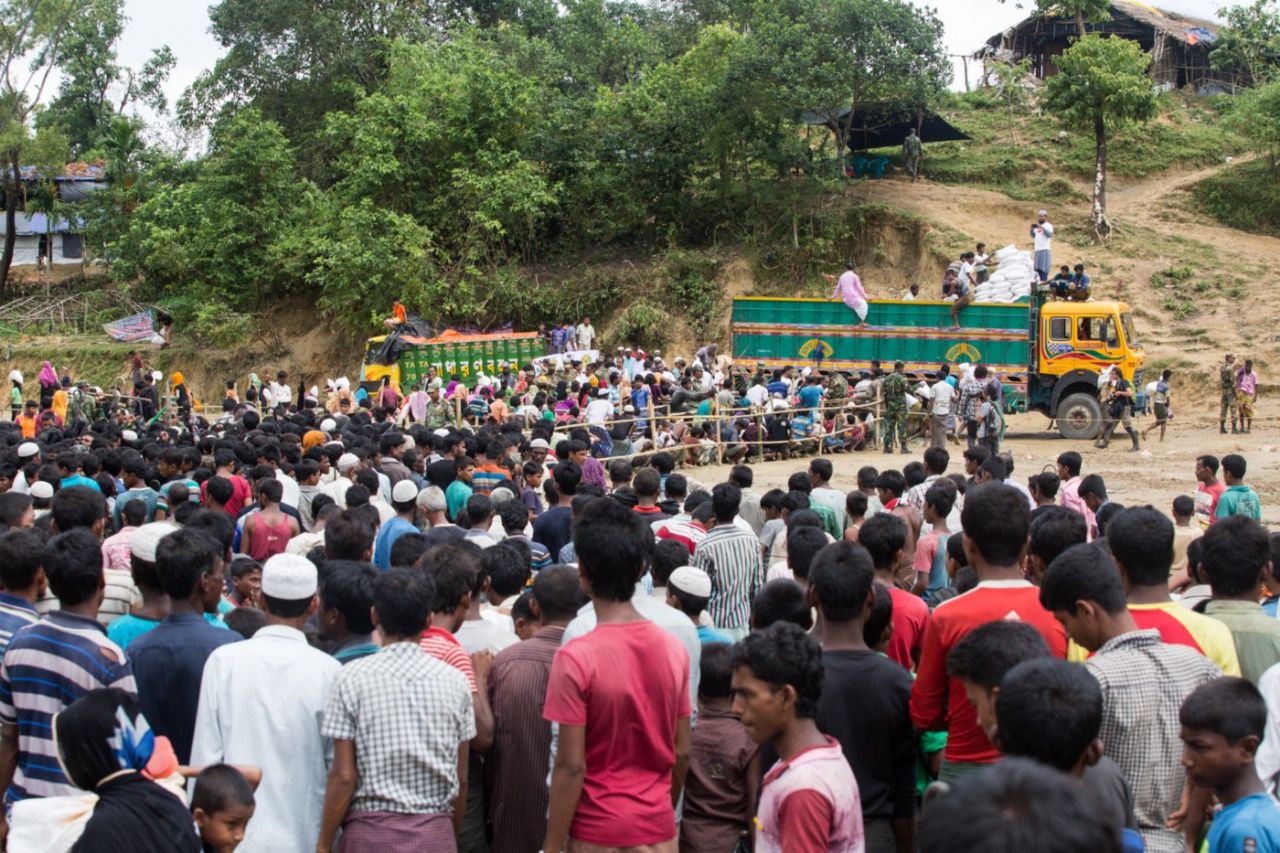
Bangladesh Army distributing food donated by individuals from across the country. Photo credit: Kamrul Hasan © BRAC 2017

A family in Hakimpara camp in Cox’s Bazar having their lunch. Photo credit: Kamrul Hasan © BRAC 2017
I remember one scene in Thaingkali, one of the smallest settlements. 20,000 people, most of them children, competing every day in an obstacle course of bamboo fences, tents and other people. The daal and rice in their plastic bowls was the only meal that many would have, and they would share it with their whole family. With an average estimated family size of five people, everyone would be hungry again by the evening and competing again the next day.
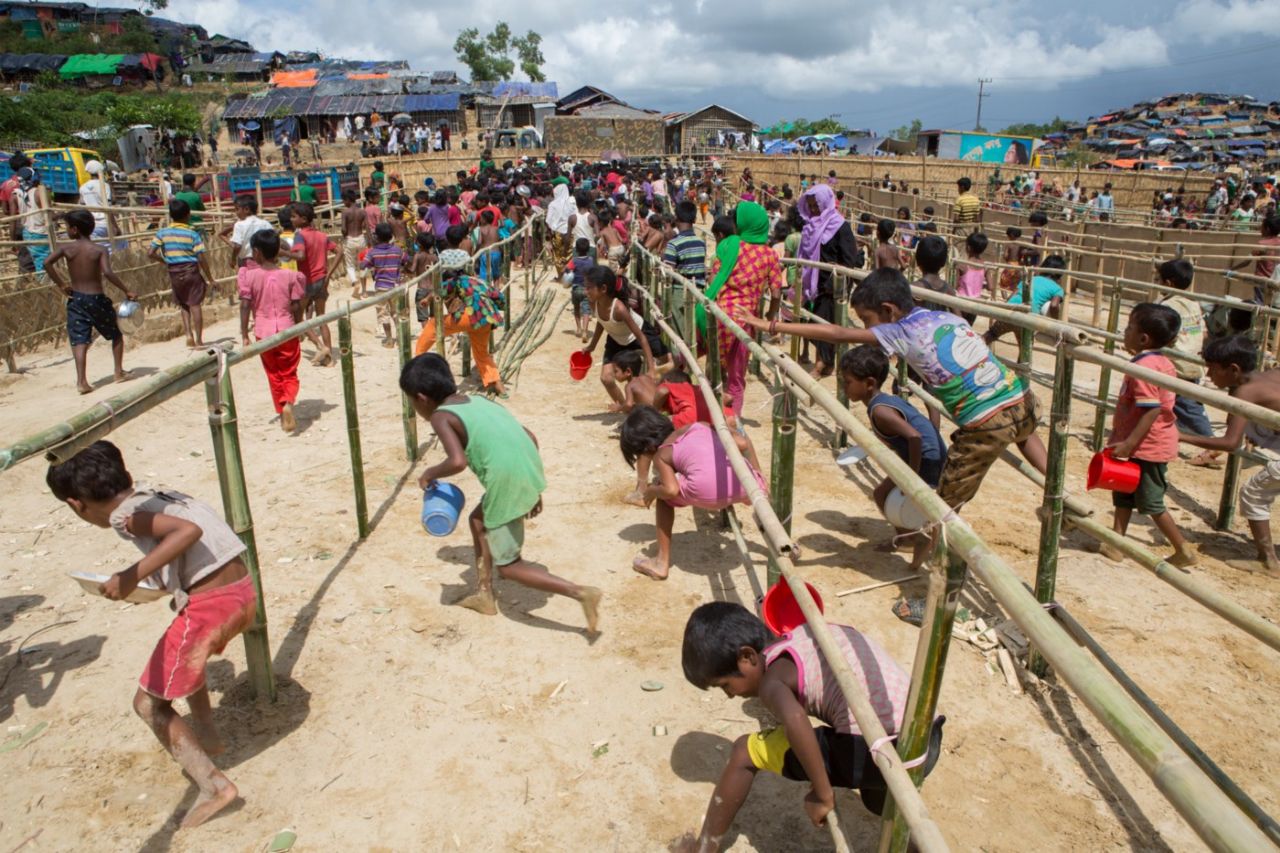
Children running for lunch at Thaingkhali Camp. Photo credit: Kamrul Hasan © BRAC 2017
The relief lines stretched for as long as you could see – if you could get to them. If you weren’t a mother single-handedly caring for young children, if you hadn’t been assigned a shelter on top of a muddy, slippery hill, or you were not an elderly person not strong enough to leave your house to collect what was sometimes a 50kg package.
Sanitation.

All of the orange cubicles are temporary latrines. Photo credit: Kamrul Hasan © BRAC 2017
There were no bathrooms on the hills. Half a million people defecating in the open. We installed 500 every day. Every one of our offices in southern Bangladesh was engaged in managing the supply chain. A cholera outbreak among half a million people was narrowly avoided.
I remember a story of a staff member in the water, sanitation and hygiene programme. He walked into the office, signed his contract and started working from the first hour. In the evening realised he had nowhere to sleep. Exhausted, he stumbled into the closest house and asked if he could sleep on the floor. They were already housing a family who had arrived. He put his bag down next to the kitchen table, next to them, and slept. Over the next week, five colleagues joined him. Eventually they all arranged accommodation, but that was weeks later. In his words – a bed could wait, saving people’s lives could not.
Health.

Health volunteer attending a mother and her newborn baby. Photo credit: Kamrul Hasan © BRAC 2017
How could you get health services to half a million people, who have just arrived, in a place that is not on a map, and does not have any roads? You set up a clinic, using an umbrella. When the line gets long, you copy it. 50 times. You move the umbrellas each day. When people start recognising you, you set up a centre that does not move. When it starts filling up, you copy that too. 10 times.
The 50 umbrellas concentrate on basic needs. The 10 fixed centres provide more complex services. Not everyone can move though, so you start walking, and visit every door. 200 health workers, doctors, midwives and paramedics, helping people wherever they are.
Our doctors and health workers saw 7,000 people per day. There were no lunch breaks. The needs were not complicated, but they were urgent. They were babies, small children, mothers and grandparents.
Child protection.

This 3-month-old baby girl’s father was killed by the Myanmar Army and her mother died on the way. A neighbour rescued her. The girl from the neighbouring family took her to one of BRAC’s child-friendly spaces. She now has friends, toys and the sound of her native songs. Photo credit: Kamrul Hasan © BRAC 2017
One of our first priorities was keeping the smallest people safe. More than half of the arrivals were children. Many of them came alone. Their tiny feet had spent weeks traversing jungles, rivers and sea. They had seen more violence in two weeks than most will see in a lifetime.
Small, cold and crying. They were at the most risk. Hundreds of colourful little centres of happiness were created. They drew pictures, sung and made new friends. Activities all children should be doing.
We were welcoming thousands of little people into our child-friendly spaces every day, and building new spaces on the hills next to them. Children were provided with a midday meal and little lost faces were reunited with their families.
Shelter.
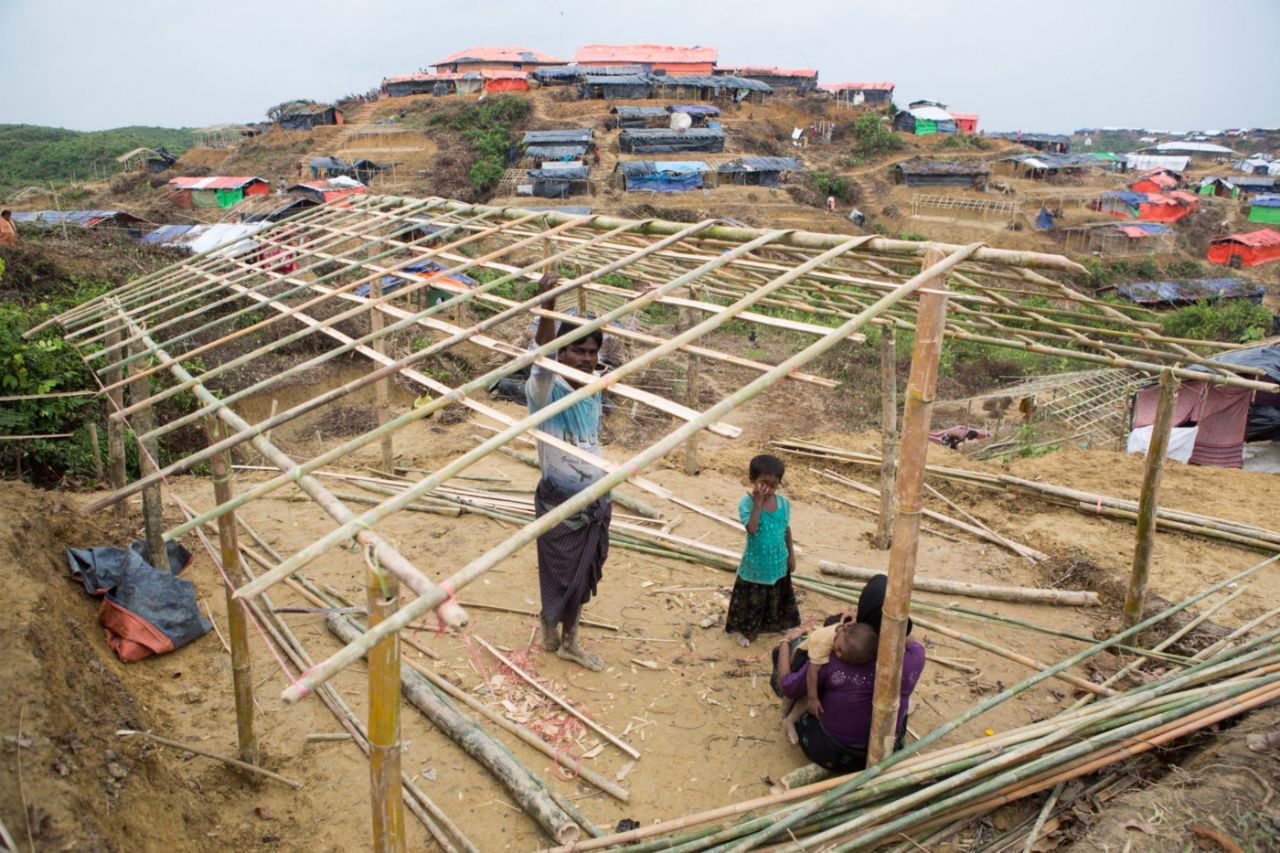
New arrival family building their own shelter with Bamboo and Tarpaulin. Photo credit: Kamrul Hasan © BRAC 2017
Everyone was homeless. Families were handed bamboo poles and tarpaulin, and built their own shelters the same day they arrived. It was swelteringly hot. Their shelters contained some relief sacks, usually some cooking pots and often a small wood-fired stove. That first night would be the first time they had slept under a roof in weeks.
Everyone sacrificed.

An Army officer looking at a picture of his newborn baby he did not yet have a chance to see. Photo credit: Kamrul Hasan © BRAC 2017
One of the stories that touched me the most was Rakib Ahmed’s. We met him on the first day of his annual leave. Bangladesh Army officers like him work for ten months straight per year and get two months off. They wait all year for that time with their families. Rakib chose to sacrifice his because of the crisis.
He showed us a picture stored on his mobile of his one-month old baby boy, which he would now not see for months. A tear came to his eye when he looked at it, but he quickly straightened his back.
“We have to sacrifice a lot, but this is what we choose. I chose to work for the Army. I chose the security of my family and their future. I never have to think about them. Everything is taken care of. I can care for other people.”
It was the same in all of Ukhiya and Teknaf. Half of a million new people in one of the world’s most densely populated countries – there was no option but to help. Schools running two classes in one room. Houses surrounding the settlements giving away farmland. Women cutting their sarees in half to give half to their new neighbours. Men giving the shirts off their backs. No one ate more than one meal of Qurbani beef.
And now, one year later, all of that has resulted in something incredible. You can see it in people’s eyes. It’s not everyone, but some eyes have sparks in them again.
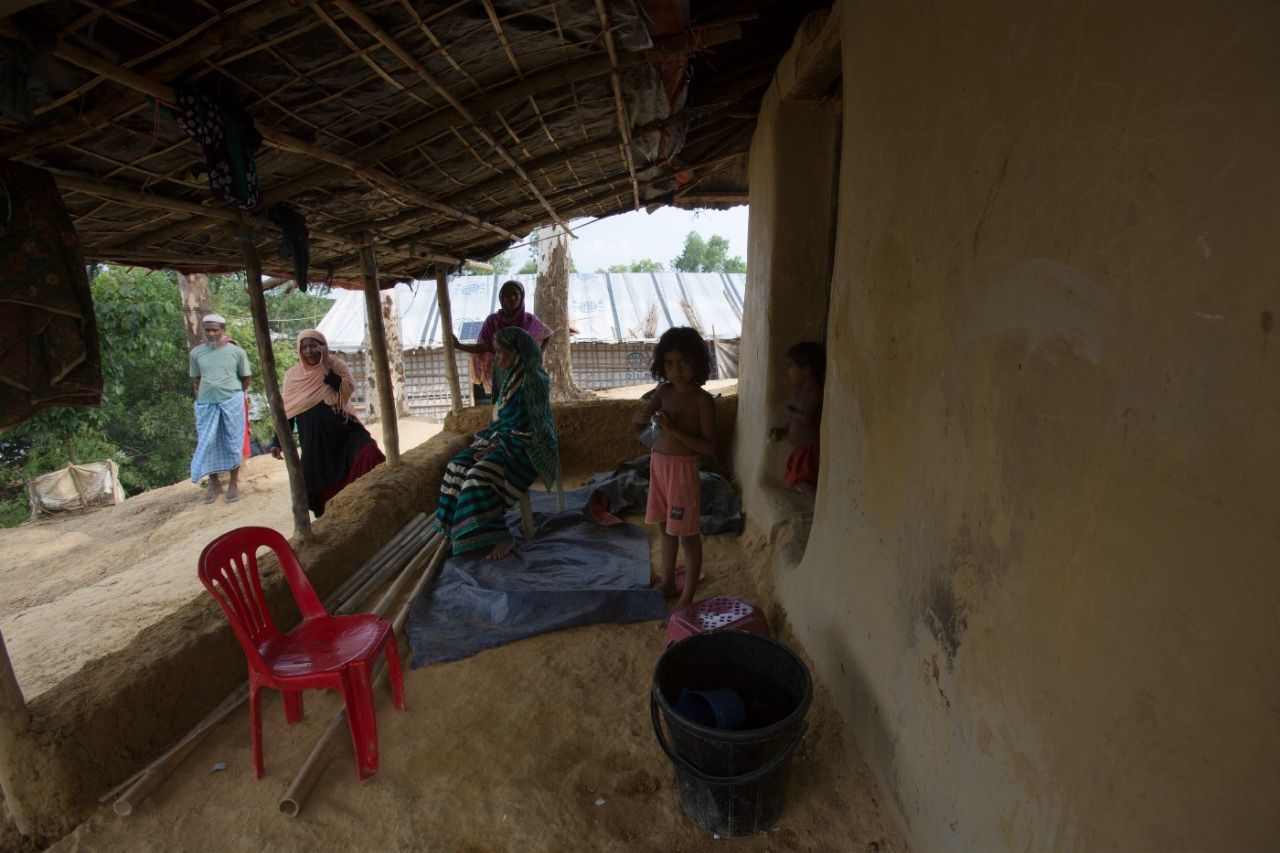
The camp starts just a feet away from a local’s door. Photo credit: Kamrul Hasan © BRAC 2017
The camps are buzzing. Market vendors yell and people bargain, the World Cup was celebrated with more fervour possibly than in Argentina itself, and learning centres ring with traditional songs. Vegetable gardens are flourishing, people are innovating independently of any organisation – building their own piping systems to get water into their shelters for example – and the community kitchens are alive with delicious smells.
A new challenge exists now, outside the camps – a perception mapping study conducted by BRAC in April 2018 showed that 30% of people surveyed in Cox’s Bazar, and 55% of people surveyed in Bangladesh welcomed the Rohingya community.
What happens now, and how we react to this new situation, is up to all of us. With the nature of civil wars changing and disputes becoming more protracted across the world, almost every country across the globe is struggling with how to cope with people who have been displaced from other countries.
There are 68.5 million people seeking safety worldwide. That’s equivalent to the entire population of Great Britain being uprooted. There are also approximately 10 million stateless people who have been denied a nationality and access to basic rights such as education, healthcare, employment and freedom of movement. We live in a world where nearly one person is forcibly displaced every two seconds as a result of conflict or persecution.
Bangladesh showed a new face to the world in accepting people arriving from Myanmar. The question now is how we will handle the long-term situation. We need to step up not just in the name of humanity, but in recognising the tangible potential to our society and economy. These people did not leave their homes by choice, and they have skills, knowledge and passion. The first thing that strikes any visitor to a cash for work programme in the camps is how hard people are working, how innovative they naturally are and generally just how good they are at any job they are given. They are all people who could make useful contributions to our country.
In Zambia, a recent study shows that refugees and former refugees are contributing positively to the country’s economy. In Uganda, research showed that 97% of refugees buy their daily goods from Ugandan-run businesses and 40 percent of the workforce employed by refugee-run businesses are local Ugandans. The Jordan Compact described refugees as “a development opportunity”, rather than a burden reliant on humanitarian aid.
Einstein was a refugee. Lord Maurice Saatchi and Charles Saatchi, founders of Saatchi & Saatchi, the world’s largest creative network, were refugees. Freddie Mercury, lead singer of rock band Queen was a refugee. Karl Marx was a refugee. From science to advertising, rock music to political concepts, there is no question about the contribution refugees have made to the world we enjoy today.
Systems of inequity have been designed by people, and they can be redesigned. We can’t fix these problems in the same way they were created — we have to use radically different methods. The question we should be asking ourselves, globally, is how much is not giving everyone in the world a chance costing all of us? I have barely left Cox’s Bazar since that hiking trip in Teknaf twelve months ago, and can testify firsthand that investment in these families is paying off with interest. Just go there and look in their eyes and you’ll see it too.
It takes us all to make a world that works for us all.
BRAC Humanitarian Crisis Management Programme (HCMP) has been working to ensure basic needs, safety and security, socio-economic opportunities in the camps and the host community for more than 1.3 million people, after an influx of forcibly displaced Myanmar nationals took refuge in Cox’s Bazar, Bangladesh.
Sarah-Jane Saltmarsh is the head of programme and enterprise communications at BRAC.



